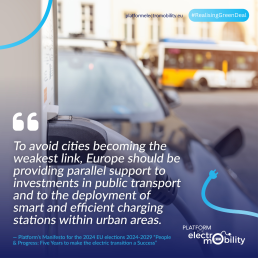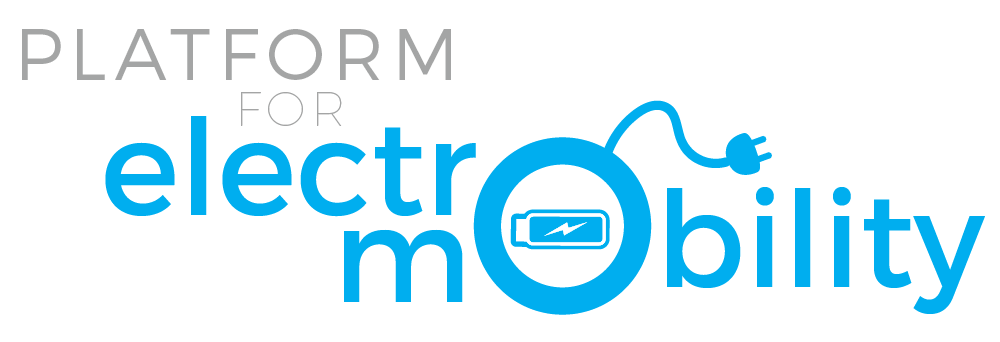30 investments priorities by 2030 for sustainable mobility
Energy, Infrastructure, Industry
Our recommendations for a “European Net-Zero Infrastructure Investment Plan
Without deployment of high-speed charging infrastructure for electric trucks, a high quality and interoperable rail network as well as integrated recycling facilities, the Green Deal will remain simply a paper tiger.
The Platform for Electromobility supports the overall shift in European policy priorities established the European Green Deal. The Deal acts as a valuable long-term compass, particularly in light of the pending elections and the appointment of a new Commission. In 2023, two pivotal pieces of legislation supporting the shift – the Net Zero Industrial Act and the Critical Raw Materials Act – were enacted. However, while these measures are welcome first steps, they call for a complementary initiative: a robust European Net-Zero Infrastructure Investment Plan.
A comprehensive Net Zero Investment Plan is essential if the EU Green Deal is to be implemented effectively within an appropriate timeframe. European companies and industries will require additional financing in order to transition to net zero, particularly given the support provided by competitors such as the US and China. Whether it is an “Investment Plan for Jobs and Clean Technologies”, an “Investment Plan for the Green Transition”, a “major investment plan to fund green industries and infrastructure” or a “massive investment spending plan for the creation of green jobs and the transformation of industry, transport and energy” – by the European People’s Party, the Party of European Socialists, the European Greens and The Left, respectively, it is clear that investment stands as a cross-partisan priority.
As outlined in our EU election manifesto, a significant investment plan post-elections is essential for ensuring the successful implementation of the Green Deal. This will benefit individuals, the climate and businesses alike, targeting sectors crucial to achieving Net Zero goals. Without deployment of high-speed charging infrastructure for electric trucks, a high quality and interoperable rail network as well as integrated recycling facilities, the Green Deal will remain simply a paper tiger. It is imperative that we make these and other long-term, easily accessible investments. Ensuring legacy of the Green Deal with a large investment plan must take centre stage during the upcoming European elections. It is the democratic moment that would legitimise such a leap forward.
At the Platform for Electromobility, our focus is on identifying priorities for the sustainable transport sectors as a whole, ensuring they work synergistically while avoiding duplication or contradictory expenditure. This document offers an overview of the required investment priorities for the myriad sectors that will constitute tomorrow’s clean mobility ecosystem. We therefore aim to support policy makers in determining the content and priorities of such a cross-partisan investment plan.
Below, 30 investment priorities in seven areas have been identified, in order to respond to three policy imperatives: deploying hard infrastructure, implementing industrial policy and supporting the shift to zero-emissions vehicles. Those priorities are closely intertwined, build on each other and create valuable synergies.
While financial considerations are paramount, they must not be the sole focus. The Green Deal also requires further legislative measures for proper implementation, such as industrial policy reforms, corporate fleet mandates and electricity market design overhauls. We have chosen to refrain from delving into financial arrangements, in order to maintain focus on our area of expertise: sustainable mobility.
30 priorities over seven areas, across three pillars.
Discover the details of the report.
1/ Investing in energy and transport infrastructure to enable the Green Deal
2/ Invest for competitive, sustainable, European transport industries
Methodology - Results are based on a preliminary questionnaire, distributed on a voluntary basis to the members of the Platform for Electromobility. The preliminary findings have been discussed and debated within each of the Platform’s six thematic working groups. The final outcomes have been validated by all members following the Platform’s Memorandum of Understanding validation processes.
Investing in off-road infrastructures to enable the Green Deal
Net Zero Investment Plan
Area 3 : Off-road Infrastructures (14.5%)
Investment in electrifying the rail network, establishing multimodal hubs, enhancing public transport, and upgrading harbors’ electricity infrastructure is vital for advancing Europe’s sustainability goals and improving transportation efficiency, necessitating significant financial commitments and strategic planning.
Investment Areas
Off-road Infrastructures Priorities
Rail Network
Multimodal Hubs
Public Transport
Harbours

- Rail Network & 12. Multimodal Hubs
The electrification of the Trans-European Transport Network (TEN-T) rail network by 2030, 2040 and 2050 presents a significant infrastructure challenge; one that will require substantial investments. Unfortunately, such investment in rail infrastructure has been sorely lacking over the past two decades. To address this, increased investment is imperative, with priority for three key areas. First, maintenance of existing infrastructure is paramount for ensuring optimal track conditions, enabling higher speeds and improving services. Second, upgrading existing network infrastructure – including implementing the European Rail Traffic Management System (ERTMS) signalisation and addressing bottlenecks – are crucial for enhancing efficiency and capacity. As acknowledged by former Italian Prime Minister Enrico Letta in his report “The future of the Single Market”, massive investments are needed to support the establishment of a comprehensive, pan-European high-speed rail network, “seamlessly linking all EU capitals and major urban centres”, with the aim “to significantly elevate rail’s role in long-distance passenger transportation, aiming to capture more than 50% of the market share”. The achievement of this initiative is presented as “a cornerstone in the EU’s journey towards enhanced connectivity, economic growth, and environmental sustainability, underscoring its profound importance for the future of the European Union”. According to the latest analysis by Institut Rousseau, an annual investment of 47 billion euros between 2024 and 2030 is required for the development of rail infrastructures to complete the TEN-T core network.
- Public Transport
Public transport – including urban rail infrastructure such as metros, trams and light rail vehicles – has a pivotal role to play in achieving Europe’s climate objectives. These systems combine high capacity, energy efficiency and safety with minimal land use, making them indispensable components of sustainable mobility. The revised TEN-T Regulation mandates that 430 major cities along the network develop Sustainable Urban Mobility Plans (SUMPs) to promote zero- and low-emission mobility. Accordingly, there must be adequate funding allocated to support alternative fuel infrastructure solutions for urban rail, ensuring that charging infrastructure is also available at key locations such as terminuses and bus stops as well as at depots. In fact, the new TEN-T mandates that airports with an annual passenger traffic volume of more than 12 million passengers shall be connected to the TEN-T railway network, including the high-speed network, allowing for long distance rail services.
- Harbours
Upgrading maritime and inland port grids, along with their connections to the national grid, is essential for powering Shore-Side Electricity (SSE) infrastructure in European ports. Starting with ferry, container and cruise ship terminals by 2025, and extending to all other terminals by 2035, SSE infrastructure will ease the transition to cleaner maritime transportation. By prioritising investments in port electrification, Europe can reduce emissions from the shipping sector and promote sustainable port operations, in alignment with its climate objectives.
Investing in charging infrastructures to enable the Green Deal
Net Zero Investment Plan
Area 2 : Charging Infrastructures (14.5%)
Investment in high-power charging infrastructure for HDVs, depot charging infrastructure for HDVs and buses, LDV charging infrastructure, urban charging networks, and residential charging solutions is essential for enabling the widespread adoption of electric vehicles and reducing greenhouse gas emissions in Europe, requiring significant investment and regulatory support.
Investment Areas
Charging Infrastructures Priorities
High-Power Charging Infrastructure for HDVs
Depot Charging Infrastructures for HDVs and Buses
Charging Infrastructures for LDVs
Charging Infrastructures in Urban Areas
Residential Charging

- High-Power Charging Infrastructure for HDVs
HPC infrastructure along motorway networks is critical for facilitating the transition to electric HDVs. While the available solutions are technically mature, it will require significant investment to kickstart the transformation. By prioritising the installation of HPC stations, Europe can ensure compliance with regulatory requirements (notably AFIR) and substantially reduce GHG emissions from the transport sector. Public money must be directed towards meeting the real needs of drivers and fleets, which is to be able to charge during rest times.
- Depot Charging Infrastructures for HDVs and Buses
Depot charging plays a vital role in electrifying trucks and buses, as a significant portion of these vehicles return to depots at the end of each day. Europe should explore opportunities for local depot-based renewable energy production support sustainable charging solutions. Depot charging infrastructure will both reduce emissions and enhance energy resilience.
- Charging Infrastructures for LDVs
Overcoming barriers, such as high purchase prices and insufficient availability of charging points, is crucial for the widespread adoption of electric LDVs. This will require comprehensive investments to ensure adequate charging infrastructure coverage both nationally and regionally.
- Charging Infrastructures in Urban Areas
Urban areas need a greater density of charging networks to meet the growing demand for electric vehicles, particularly among residents without access to private parking spaces. Public charging points are pivotal in enabling urban dwellers to switch to electric transportation.
- Residential Charging
The residential sector is central to decarbonising the LDV fleet, as a majority of charging events take place at private residences. Furthermore, the installation of a controllable charging station is the most economical solution for the customer, the most energy-efficient for the grid, and promotes off-peak/super-off-peak charging. However, retrofitting existing buildings and electrical installations to accommodate charging points requires significant investment. Europe should assist with the renovations required to ensure widespread access to residential charging infrastructure, and support consumers in purchasing charging points. In addition, financial support for building-related costs – such as electrical upgrades and grid connections – is essential for encouraging the widespread adoption of electric vehicles in residential settings.
A Comprehensive Roadmap for V2X Integration in Europe
Energy & Infrastructures
A Comprehensive Roadmap for V2X Integration in Europe
The paper outlines enablers and barriers concerning bidirectional charging systems, clarifies key barriers, highlights ongoing efforts to mitigate them, and underscores the critical need for concerted and regulatory actions to achieve the transformative potential of V2X integration.
Electric Vehicles (EVs) both pose particular challenges and present promising opportunities for the energy system; they mark a pivotal moment in the evolution of transportation and energy sectors. With the increased adoption of EVs lies the imperative for strategic planning and collaborative action on Vehicle-to-X (V2X), a crucial technology for smartening the road transport sector.[i]
Recently adopted legislation – as part of the European Green Deal – has already paved the way for the roll-out of smart-charging technologies in the electromobility ecosystem.[ii] We welcome these initiatives and will monitor their implementation closely. Smart charging is a fundamental prerequisite for V2X, which will deliver further advantages for people, the climate and European businesses alike.
Recognising this, this document from the Platform for Electromobility seeks to present a comprehensive roadmap on V2X, setting out a series of actionable steps that by Member States (MS) should undertake, along with measures required at the EU level. Stressing the importance of a cross-sectoral approach, our strategy seeks to navigate the complexities of V2X integration in our energy system without delving too deeply into intricate technicalities. The paper outlines enablers and barriers to adopting bidirectional charging systems, clarifies crucial barriers – and highlights ongoing efforts to mitigate them – and underscores the imperative for concerted and regulatory action to realise the transformative potential of V2X integration.
1/ Benefits of bidirectional charging

a/ Benefits for public finances & grid investments
V2X integration offers a multifaceted solution, one with the potential to unlock a wide range of benefits across various domains. Foremost among these, V2X – as with other flexibility resources – complements conventional grid reinforcement measures, helping alleviate the strain on existing infrastructure while enhancing its resilience. We are already starting to see increasing tensions in the grid and the overwhelming need to reinforce it; therefore, the deployment of V2X and the use of EVs as batteries represents a ‘no-brainer’[i] and would effectively smooth the rollout of grid reinforcement, something that usually takes between 5-15 years. V2X integration thus offers access to a realm of ‘low-hanging fruit’ opportunities, allowing the cost-efficient adaptation of the grids to growing electrification.
b/ Benefits for Europe energy autonomy
The integration of V2X will help deploy renewable energy sources (RES), by providing efficient storage solutions. It has the potential to help balance the grid and increase the penetration of renewable electricity (RES-E) into it, thus accelerating the drive to climate neutrality. Indeed, in order to ensure generation adequacy – key for the energy transition – V2X will be pivotal. As intermittent renewable energy becomes increasingly prevalent, maintaining grid stability and meeting demand poses significant challenges. Here, V2X solutions can play a crucial role in balancing supply and demand, enabling dynamic resource adequacy analyses that realise the enormous potential of V2G capabilities.
c/ Benefits for grid operators
From the perspective of the grid operators, there are manifold advantages. For Transmission System Operators (TSOs), V2X is particularly beneficials for Frequency Regulation (FCR) Services, which are pivotal functions for TSOs. In addition to mere savings in battery costs, V2X optimises both standalone and grid-connected storage battery systems. FCR plays a critical role, not only in reducing the necessity for investment in battery storage services but also in minimising the need for grid upgrades. These efficiencies translate into systemic savings, ultimately benefiting electricity consumers. For DSOs, V2X can play a major role in local flexibility markets and congestion solutions providing services to DSOs and representing a valuable flexible resource that can be procured to ease tensions on distribution grids. This requires flexibility mechanisms in which V2X value can be stacked based on related remuneration. To enable even more value of V2X for every DSO, market based procurement of flexibility based on V2X shall be stimulated.
d/ Benefits for users, people and businesses alike
From an end user’s perspective, the benefits of V2X integration will be substantial. Through leveraging V2X capabilities, users will have the opportunity to earn money from feeding energy into the grid, thus enhancing the overall value proposition of electric mobility.[ii] Remuneration mechanisms (such as those based on availability, capacity or time) will trigger further consumers to participate; once they do so, they will naturally generate demand for V2X. V2X integration will not only enhance grid resilience and promote renewable energy uptake but also pave the way for a more sustainable, efficient and adaptive energy ecosystem, one where EVs can equally participate in flex mechanisms.
2. Legislative and Regulatory Principles for V2X Integration

As we call on legislators to begin shaping the regulatory framework for V2X integration, there must be a number of core founding principles that underpin their efforts to foster innovation, interoperability, fairness and trust within the emerging ecosystem.
a/ Consumer trust
Foremost among these principles must be building and maintaining consumer trust. Legislators must prioritise creating a robust system that instils trust among users, system operators and businesses alike. This will entail ensuring transparency and accountability in V2X transactions while also safeguarding consumer rights and interests.
b/ Business models based on use cases
The deployment of V2X infrastructure must be accompanied by corresponding business models, particularly where financed/cofinanced by public entities. As the value of V2X depends on the use case of fleet and chargepoints, there need to be proper business models created that provide an incentive for consumers. Regulators should therefore facilitate mechanisms to support user compensation and fair pricing; these should recognise the pivotal role granular pricing structures play in enabling diverse business models and in incentivising dynamic energy management. The increased volatility in our energy system arising from renewables and negative grid tariffs can further stimulate consumers to engage and participate in V2X initiatives.
c/ Commonly accepted and harmonised standards
The promotion of common standards is paramount for ensuring interoperability and reliability across V2X systems. These should allow the CCS standard to provide smart and bidirectional charging. This should be implemented as early as possible in both charging stations and cars. Any further delay will lead to infrastructure that is not future-proof and will fail to deliver the smart-charging services we will need for the energy transition to succeed. Standardisation bodies should prioritise development and enforcement of standardised protocols for battery efficiency and warranty and for EV charging protocols between both the grid and vehicle. This will bolster consumer confidence and trust in V2X technologies.
d/ Affordability through democratisation
The accessibility and affordability of V2G-capable vehicles must be a priority if access to this transformative technology is to be democratised. By incentivising competition and innovation in the production of V2X-capable chargers and EVs as well as through lowering the barriers detailed below, legislators can drive down costs and promote widespread adoption. This in turn will create economies of scale and lower barriers to entry. With the right regulatory framework in place, recharging costs can theoretically be brought down to zero with bidirectional charging.[i]
e/ Equal treatment for all grid usages
Ensuring equal access, participation, and treatment for all energy usages, including all type of V2X, is fundamental. All grid users should receive equal treatment without discrimination, be they electric vehicles, wind turbines or home appliances. Any exceptions – such as tariff exemptions – should be restricted to emerging user groups, should remain temporary and should be appropriately justified.
f/ Upgradability path
In envisioning the regulatory framework for V2X integration, it is imperative to prioritise establishing future-proof systems capable of evolving alongside advancing technologies and changing needs. Although V2X technology is not as yet fully harmonised across Europe and still faces barriers, its early rollout is needed in order to facilitate improvements. Central to this endeavour is the need for an ‘upgradability path’, embedded within the regulatory framework. Such a path will not only instils trust among consumers and markets but also ensure compliance with future technological advancements and emerging requirements.
g/ Public charging hidden potential
In Europe, a significant proportion of the car fleet lacks access to home charging. As a result, publicly available charging will continue to be necessary in the future. This presents an opportunity to leverage V2X technology at these points also. We therefore encourage public charging points to be V2X-capable; this is provided that the cost-benefit analysis is positive, they are priced similarly, only implemented on slow chargers and do not impede the rollout of charging stations across Europe.
3. Barriers to V2X Deployment

Despite the potential offered by V2X integration, several barriers continue to hinder its widespread deployment. Overcoming regulatory, technical and market hurdles will require concerted efforts.
a/ Implementation of the Electricity Market Design
At the forefront of these challenges are regulatory barriers, most notably the lack of implementation by MS of the 2019 Electricity Market Design, which discriminates and disincentivises the participation of V2X in the electricity markets. To address this, there is an urgent need for MS to accelerate their implementation.
b/ Double Taxation
One of the asks of battery stakeholders (EVs and stationary) is to eliminate double taxation; that is, the taxing again of electricity injected into the grid from a battery. Double taxation[i] remains a persistent concern, particularly in scenarios where energy storage is integrated with other loads. While progress has been made in mitigating double taxation for large-scale storage, challenges persist for small-scale storage assets such as V2X. For example, in Germany, double taxation for stationary storage has been removed, yet remains in place for mobile storage.
c/ Uncoordinated grid requirements
The absence of the anticipated regulations, coupled with limited access to organised markets and revenue streams, poses significant challenges to V2X deployment. Uncoordinated grid requirements and standards between countries are exacerbating these challenges, hindering interoperability and complicating cross-border deployment efforts. Divergent communication standards and disparate smart meter adoption rates – something that is particularly evident in countries such as Germany, which has low penetration rates – underscore the urgent need for harmonisation and standardisation initiatives to realise the full potential of V2X integration.
4. Call for coherence, actions and political ownership at EU level

a/ Coherence across Member States
As the EU navigates the complexities of V2X integration, it is vital to address the prevailing divergences among MS and to foster a cohesive regulatory framework that promotes innovation and harmonisation. Despite incremental progress, no MS has successfully removed all barriers to V2X deployment, underscoring the imperative for EU-level intervention. For V2X for slow public charging, we therefore call for national capacity targets – rather an EU-wide one – because the share of cars without access to off-street parking at home differs significantly between MS.
b/ Coherence across EU legislations and regulations
To advance implementation of V2X and harness its manifold advantages within Europe, it is crucial that the newly installed European institutions adopt a holistic approach to this challenge. All V2X-relevant measures should be in the form a comprehensive regulatory framework, rather than addressing them in isolated discussions, or rather than discussion technologies (AC vs DC). One way of ensuring this seamless integration across diverse legislative frameworks – and avoiding a fragmented approach – is to establish political ownership.
c/ Multilevel coherence on V2X
Cities will, in general, be the key enablers and accelerators of V2X due to the alignment between clean air and decarbonisation strategies (such as growing adoption of zero-emission zones, electrification of heating as an alternative to petrol/gas/wood). V2X should therefore be part of an integrated mobility and energy strategy at all territorial levels. We therefore call upon the EU to adapt the proposed SUMPs/SULPs into SUMEPs/SULEPs (Sustainable Urban Logistics/Mobility and Energy Plan). This will ensure coordinated and integrated planning, helping couple mobility/logistics with energy aspects
d/ Double mandate to jumpstart the market.
Mandating V2X interoperability for all bidirectional-capable vehicles, while at the same time requiring V2X capability for public fleets and buildings would be decisive in kickstarting the market and boosting widespread adoption. It would also ensure flexibility for independent aggregators and promote the use of submeters. Requiring interoperability and encouraging public fleets to lead by example will help jumpstart the market.
Conclusion
Additional measures, including addressing communication standards and issuing non-binding guidelines for MS, will be essential for fostering coherence and facilitating the transition towards a sustainable, interoperable V2X ecosystem. With upcoming revisions to key pieces of legislation now on the horizon, it is an opportune moment for the European Commission to demonstrate leadership and to spearhead concerted action to achieving V2X integration goals. By embracing coherence at an EU level, policymakers can unlock the full potential of V2X technologies and accelerate the shift to a smarter, greener future.
Introduction [i] V2X is an EV bidirectional charging technology encompassing several sub technologies: When the vehicle is plugged and electricity automatically flows from the car back to the grid, this is known as Vehicle-to-Grid (V2G). If the charging and discharging of electricity stored in electric vehicles takes place in buildings, this technology is known as Vehicle-to-Building or Vehicle-to-Home (V2B or V2H). [ii] Notably in the Energy Performance of Buildings Directive, the Renewable Energy Directive and the Alternative Fuels Infrastructures Regulation The benefits of bidirectional charging [i] It has been calculated that V2G can offer 21TWh of upward flexibility, and 24TWh of downward flexibility by 2030, considering 30% of the EVs are charged bidirectionally. Together with other flexibility resources, €11 to €29 billion could be saved in annual savings in distribution grid investments. Source : https ://smarten.eu/wp-content/uploads/2022/09/SmartEN-DSF-benefits-2030-Report_DIGITAL.pdf [ii] In a fleet demo in Denmark, a 10-EV fleet engaging in frequency regulation (FCR) services recorded an average revenue of € 1,860 per car per year[ii]. In a residential V2G project connecting 320 homes in the UK, the V2G units were able to create ‘between £230 and £300 of value per year through the spot electricity market’ and the project team expects that ‘when combined with flexibility services this could grow to £500 per year[ii].’ In the UK, a solution already commercialized proposes the first V2G tariff in the UK where EV drivers would get free charging thanks to their V2G charger and vehicle[ii], providing clear incentives and enhancing the social acceptance of the consumer to opt for bidirectional charging. Source: https://www.ofgem.gov.uk/publications/case-study-uk-electric-vehicle-grid-v2g-charging Legislative and Regulatory Principles for V2X Integration [i] Source: https://smarten.eu/position-paper-why-flexible-consumers-matter-a-contribution-to-eu-elections-2024/, p 9 Barriers to V2X deployment [i] In fact, battery stakeholders face a triple taxation. Once when the energy is taken from the grid, twice when part of the energy is injected into the grid, and a third time when that electricity is used somewhere else. The electricity injected to the grid should not be taxed when taken by the battery nor when injected back into the grid.
Recommendations for the deployment of sustainable infrastructure of BE HDVs
Logistics & Infrastructures
Driving the adoption of Battery Electric Heavy-Duty Vehicles
General policy recommendations for the deployment of sustainable infrastructure
The members of the Platform for electromobility recognise the importance of driving uptake of the required infrastructures for Battery Electric Trucks and buses (BEHDVs). They also recognise the need for policy recommendations that complement the Alternative Fuels Infrastructure Regulation (AFIR) and Energy Performance of Buildings Directive (EPBD).
The challenges in this area span multiple sectors, from energy, through land management and on to data security. We therefore emphasise the importance of cooperation between all sectors of the electric road transport system, resulting in this paper, which outlines the key elements that legislators should keep in mind when addressing this topic.
In this position paper, we identify three areas that require attention and provide policy recommendations to ensure the successful roll out of infrastructures for BEHDVs: the grid, the data framework and the land.
Beyond infrastructure (which this paper is dedicated to), we stress the importance of ambitious, clear and timely revision of both the CO2 Standards for trucks and buses Regulation and the Weights and Dimensions Directive. We have discussed both of these in previous publications (respectively here and here).
The grid

A. Assessments: per country and per usage
While strong CO2 Standards would prove useful for anticipating actual and future demand, a situation where a grid connection may not be available can potentially undermine the trajectory defined by those new CO2 Standards. It therefore becomes urgent to immediately and proactively assess whether there is sufficient potential grid-capacity to allow for sufficient connection for the charging infrastructure needed for BEHDVs. Assessment becomes all the more pressing when considering the lengthy lead times, the need for grid reinforcement, the likely demand for BEHDVs and the number of actors involved.
Grid infrastructure varies between countries. Some may need important investments in order to prepare for the integration of BEHDVs, with the development of megafast chargers where required. In the Netherlands – a European Member State at the forefront of road transport electrification (along with other such as Germany and, to a lesser extent, Belgium) – it appears to be extremely difficult for transport operators to obtain the needed capacity for BEHDVs, both at their depots and on the road, due to a lack of effective planning. Even where capacity increases are possible, long delays for connection and procedural constraints present barriers to the swift adoption of BEHDVs.
Grid infrastructure varies between usages. While large charging hubs for BEHDVs along motorways will be the exception and the depot/destination charging overnight the rule, the need for very high-level connection capacity along the motorway should be tackled. Medium- and high-voltage connections to the power grid will be necessary to support the fast charging times in the event of opportunity charging. To deliver the necessary power capacity, grid strengthening may be required at both public locations and – for different reasons – at private charging depots/distribution centres.
BEHDVs-suitable charging locations can be mapped and the power needs for those locations assessed. Recent existing mapping[1] – based on the GPS records of large numbers of trucks routes during one year throughout Europe – can provide a good starting point. Truck stakeholders can subsequently confirm or propose new locations for the recharging infrastructure and the power required. Distribution System Operators (DSOs) and Transmission System Operators (TSOs) should confirm whether there is sufficient capacity and, where necessary, propose alternatives.
We would welcome support for undertaking a similar mapping exercise for coaches and interurban buses. Such analysis would also support the task forces (see below) in deciding the pre-equipment needed for depots and distribution centres, as well for existing service stations. This would ensure that delays in installing charging stations for BEHDVs do not exceed reasonable timescales.
Mapping analysis shows some 10% of locations will account for half the opportunity charging stops.[2] Pre-identifying these would help accelerate the coordinated development of charging infrastructure for BEHDVs and facilitate discussion within the dedicated task forces.
B. Task Forces
The task forces – constituted as follows – should be established and moderated by transport ministries or designated government agencies. National task forces: DSOs or their representations; TSOs; manufacturers of BEHDVs, BEHDVs operators and national associations[3]; representations of energy aggregators operators; fleet managers; road and urban planners; national Charging Point Operator (CPOs) associations.
Such task forces would be well suited for indicating the investments required to extend and reinforce charging infrastructure and to determine suitable charging locations and power requirements. This will enable DSOs and TSOs to plan the necessary grid extensions and reinforcements. This is extremely important for those areas that are not being developed by project developers due to high investment costs and long lead times for grid connections. The bottom line for achieving a comprehensive approach to planning involves early engagement with fleet managers, road operators, local municipalities, CPOs and grid utilities. Such an approach helps in proactively addressing public acceptance, potential land use challenges and in establishing a workable and timely power delivery schedule.
C. National deployment plans
In order to forge a stronger link between the AFIR implementation and the deployment of charging infrastructure for BEHDVs, we propose that Member States base their own national deployment plans on the AFIR targets, reflecting the anticipated demand at each location.
These plans should align with the anticipated demand for BEHDV charging, while also considering such factors as traffic density and projected growth in BEHDV usage and stops. By adopting such an approach, Member States can provide network operators and other stakeholders with longer lead times for planning future infrastructure uptake and anticipated connection requests, particularly post-2030.
D. Public & private investments
A high-capacity grid does not come without costs. Ultrafast charging stations are expected to require large MVA network connections, which usually occur directly at high voltage level but can also occur at MV level, depending on Member State specificities.
Well-designed European financing programmes can attract private investments for BEHDV infrastructure development. To facilitate implementation, and considering the high CapEx involved, public funding should be made available: The Connecting European Facility (CEF) is a vast programme, one that is primarily focused on passenger cars rather than on BEHDVs. This limits its alignment with the needs of the heavy-duty vehicle sector. Typically, the Alternative Fuels Infrastructure Facility (AFIF) Call of the CEF Programme supports BEHDVs infrastructure between 150kW and 350kW while for 800kW and higher, power the financial solutions provided by European Commission are too limited. The annex should be adapted to better take account of the needs of BEHDVs.
2. The Data Framework

A. Align grid codes, regulations to ultrahigh-power charging standards under development
The introduction of ultrahigh power charging standards necessitates global and European recognition. When being designed, standards should take into account factors such as space and interoperability as well as the futureproofing of those ultrahigh power charging standards currently under development. Any existing regulations that did not anticipate BEHDVs and their charging infrastructure must be updated to in order to accommodate this new paradigm. Definitions of technical aspects and use cases must be integrated into existing technical codes and regulations. Temporary exceptions will likely be required in areas such as standardised and certified energy metering concepts, which are currently lacking for megawatt charging. Member States should implement standards for BEHDV infrastructures for both public and private applications. Last, it is not possible to apply to EU funding for deployment of standards that have yet to be adopted.
B. Harness the flexibility potential of BEHDVs
Smart and bidirectional charging can be key in increasing the uptake of renewable energy and in offering flexibility potential to the grid. While initially this may seem challenging to implement, given the fast-charging requirements dictated by the road transport business model based on opportunity charging. Yet, the potential to harness the flexibility of the BEHDVs is actually significant, particularly considering their battery sizes, the high predictability of their routes and time schedules and the predominance of depot/overnight charging.
Smart energy management systems can therefore be deployed, specifically through the implementation of balancing mechanisms between connectors. This will synchronise with renewable energy production and provide a fast-frequency response to keep the grid stable. This would further require signals to use the flexibility from batteries, such as incentives for aggregators and dynamic tariffs, etc. Beyond advanced planning, tariffication incentives and financial incentives in the grid services markets are other crucial elements for minimising grid impact and allowing potential grid balancing.
Bidirectional and smart charging can be particularly suitable for certain business models, notably buses and trucks that are not operated on a 24/7 basis (short-haul and regional transport). Their large batteries can offer key services to the grid. Smart meters should be considered as one of the solutions for smart charging in depots and distribution centres. However, regulatory frameworks will need to be adapted in order to enable bidirectional charging and provide economic incentives.
Finally, the sector is currently exploring the potential of flexible storage positions within local energy systems, such as incorporating stationary batteries into charging stations or exploring battery swapping solutions. Such approaches can help reduce the strain on the grid, offering advantages to both charging operators and system operators by enhancing flexibility. In addition, configurations integrating renewable energy sources on site should be examined for smart charging, as they have the potential to mitigate expected peak loads.
C. Data sharing for smooth logistic operations
A proper regulatory framework would also enable data and information exchange along with digitalisation for cross-sector integration:
Smooth reservation and non-discriminatory access to, and reliable operation of, public recharging infrastructure can accelerate the transition to BEHDVs. Standardised data sharing and interoperability between value chain players are a prerequisite for third-party operators of smart charging services and for the proper functioning of smart charging technologies.
Currently, however, data sharing and interoperability are often limited, which can lead to inefficiencies and reliability challenges. For example, charging point operators may not have access to real-time data on the location and battery state of charge of heavy-duty trucks. This in turn can make it challenging to plan optimal power needs and manage the charging process. Likewise, logistics operators may not have access to real-time data on the availability of charging infrastructure, which can lead to delays in delivering goods. There are multiple data types for multiple use cases that require a minimum of data sharing across the industry to enable efficient logistics and reliable charging.
Agreeing minimum specific list of data points for BEHDVs, interoperability standards and developing a robust, open and non-discriminatory data sharing framework will allow logistics operators, truck manufacturers, grid and charging point operators to put solutions in place for improving the reliability and efficiency of logistics operations and recharging infrastructure.[1] The European Commission should support the parties involved, with the aim of establishing an open data-sharing framework built around a set of industry-agreed data types, made accessible to the market and public authorities. Ultimately, it should strive to establish a reliable European legal framework for smooth data exchange for electric HDV recharging operations throughout the EU.
D. Understand the charging patterns
Last, further research is required to understand the charging patterns and to demonstrate the cost opportunities for transport operators and Mobility Service Providers (MSPs) of participating in the flexibility services market. TSOs – in collaboration with fleet operators – can play a crucial role, for example by introducing pilot projects and regulatory sandboxes to gather experience on grid impacts and reactions to time-varying tariffs, and to eventually assess the real flexibility potential.
The Land

A. Quantity: Sufficient space for trucks and buses public and private charging
According to the European Commission[1], there is a shortage of around 100,000 suitable parking spaces for HDVs, of which only around 54,000 offer a reasonable standard of safety. We can therefore no longer ignore the shortage of parking space for truck drivers. This current lack of parking leads to improperly parked trucks, leading to both environmental and safety issues for truck drivers and other road users and places a considerable burden on truck drivers. Even existing parking areas frequently lack adequate facilities or are in a state of disrepair.
The need for additional charging infrastructure created by the advent of electrification makes these issues even more acute. Consequently, the availability of ample parking space – now in parallel with charging facilities – represents more than a mere convenience; rather, it is an indispensable prerequisite for driving the transition to a decarbonised transport system.
B. Quality: Safe and Secure Truck Parking Areas (SSTPAs) suited to charging
Private investment in constructing increasingly costly infrastructure such as large-scale parking facilities, warrants reinforcement through European and national public funding initiatives. Such incentives include grants, tax benefits and subsidies geared to attracting private investment in the construction of parking areas with integrated charging stations for BEHDVs. Such moves can help offset initial infrastructure costs and incentivise the expansion of such facilities. While establishing more ambitious – yet attainable – targets for each Member State at an EU level emerges as a sensible strategy, the reality of achieving these minimum standards is frequently faced with lack of available land, particularly in densely populated areas. To overcome this challenge, the EU should support Member States in pursuing following options:
- Earmarking publicly owned land for investors to develop new parking and charging spaces. Alternatively, streamlining the permitting process and alleviating bureaucratic complexities to incentivise private investments in additional parking capacity.
- Enhancing the synergy between private landowners and operators of parking and charging spaces through improved matchmaking mechanisms and by leveraging digital platforms.
- Tendering (greenfield) locations where investors are hesitant via a ‘concession model‘, eventually combined with incentivised deployment on certain locations. In a concession model, governments can accelerate permitting and realisation of grid connections.
- Cooperating with system operators to secure grid capacity on shared (or tendered) locations.
C. Must-have for market models
Other market models (land sale, rental, long lease) are viable alternatives, but lead to more commitment in implementation (profitable business case, cooperation, multiple operators on one site). All market models should consider monopoly on ‘premium’ sites, market forces in designated locations, differences between HDV and LDV infrastructure markets and maximising market forces.
D. The role of concession holder
In essence, the role of concession holder can play an ever-more prominent role in accelerating the market by:
- Taking the lead in all restrictive conditions (such as grid connection, land ownership)
- Securing grid capacity before locations are offered for tender. Participate with system operators to secure grid capacity on multisite (multiple operators using a single grid connection). Facilitate consortia to own and initiate a shared site with multiple operators of zero emission infrastructure.
- Acting as a bridge function in sharing construction and basic infrastructure costs when multiple operators settle on a site (such as direction on site layout, site paving).
- Promoting a location for charging infrastructure operators by attracting other services (retail, hospitality, etc).
The Grid [1] https://www.acea.auto/press-release/electric-trucks-new-data-maps-out-priority-locations-for-charging-points/ [2] https://www.isi.fraunhofer.de/content/dam/isi/dokumente/cce/2021/ACEA_truckstop_report_update.pdf [3] Shippers and carriers such as TLN in the Netherlands or RHA in the United Kingdom. The Data Framework [1] Smart charging, BET eRoaming, Plug and Charge, Value Added Services (i.e., Preconditioning), flexibility provision services in relation to battery degradation patterns etc. The Land [1] https://www.iru.org/system/files/Final-Report-SSTPA-27022019.pdf
Recommendations to trilogue negotiators on EPBD
EPBD Trilogue
Our recommendations to negotiators
In 2023, battery electric vehicle (EV) sales reached a milestone, accounting for 15% of total sales in the European automotive market. At the same time, about 25% of bicycles sold are e-bikes. These positive trends are expected to continue, driven by ambitious EU objectives and legislations and national recovery plans.
To ensure the success of Europe’s transition to zero-emission mobility, the deployment of private charging infrastructure is of utmost importance, given that 75% of all charging takes place at home or in the workplace. While the EPBD consider the upcoming needs of electromobility, we believe that safeguarding the strongest agreements are needed to establish the right conditions for widespread EV adoption.
The Platform for electromobility fully supports the revision of the EPBD, particularly the introduction of Article 12, which focuses on electromobility infrastructure in buildings. We commend to preserve provisions that guarantee a strong and coherent right to plug in all buildings, remove regulatory barriers, and require smart charging-readiness for new and renovated chargers, among other measures.
As the EU institutions start trilogue talks, it’s clear the European Parliament wants more than the Council. But the many exceptions for installing infrastructure could make things confusing and inconsistent across Europe, we would like to present five additional recommendations:
- Clarify the scope of application of Art 12
The current wording could be interpreted restrictively. We seek clarification to ensure that requirements apply to parking spaces both adjacent to and inside buildings.
- Ensure charging solutions in existing buildings
Given that a significant portion of existing buildings will remain in use by 2050, we propose extending the scope of Article 12 to require clear and transparent rules for EV charging points in existing buildings. Incentives and compliance mechanisms should be introduced.
- Complete charging requirements for new and renovated buildings
Extend requirements to cover depots, logistic hubs, and distribution centres, ensuring they are ready for future EV charging.
- Reinforce smart charging functionalities
Mandate that all newly installed chargers in buildings are capable of smart charging. Ensure consistency in definitions and provisions with related regulations and recognize the value of mobile storage.
- Reinforce measures to ensure pre-cabling
Provide an explicit definition of pre-cabling, inform about readiness in Energy Performance Certificates, and simplify permit and installation procedures. Address administrative hurdles and encourage Member States to financially support EV charging installations.
- Ensure adequate bicycle parking:
Opt for bicycle parking to represent 15 % of total user capacity in non-residential buildings, and with space required also for bicycles with larger dimensions than standard bicycles.
- Reject opt outs for SMEs
98% of all commercial enterprises are SMEs, therefore the Directive would no longer apply to 98% of commercial non-residential buildings. This is a tool that is too moderate.
- Re-ensure provision on Right-to-plug
The Right-to-plug lowered since in point 8 both co-legislators mentioned a “request by tenants or co-owners to install CPs can only be refused if there are serious reasons for doing so”. This could weaken provision on Right-to-plug, giving the possibility to landlords and condominium assemblies to refuse the Right-to-plug and install a charging infrastructure in not so clarified cases. We call to remove or clarify the point 8.
- Preserving precabling
In contrast to prevailing targets, where the European Commission’s proposal advocates for 100% precabling, the Council suggests a balanced approach of 50% precabling and 50% ducting. Additionally, in the case of new and renovated residential buildings, the Parliament recommends a complete shift towards 100% ducting if 100% precabling is deemed unfeasible. However, we propose retaining the precabling targets in alignment with the European Commission’s proposal. This approach ensures the preservation of cost-efficiency in future installations and reinforces the fundamental right to access plug-in infrastructure.
Now, it’s crucial for policymakers to act and make sure that every European can charge their electric vehicles at home and work, be it an EV or an e-bike. This is where most EV charging happens already. By doing this, we can make EV charging available to everyone and fully harness the environmental benefits it offers, contributing to the development of an energy system powered by renewables.
EU Election Manifesto: Investment Plan to Implement the Green Deal
Manifesto Second Pillar
An Investment Plan
to Implement the Green Deal

The 2023 Net Zero Industrial Act and the Critical Raw Materials Act needs an accompanying European Net-Zero Infrastructure Investment Plan. A long-term, easy-to-access investment facility – aimed at sectors key to Net Zero – should be a core issue during the European elections.
Freight and logistics infrastructure are a vital component in the movement of goods within Europe. There should be comprehensive investment in developing and deploying sustainable logistics infrastructure. The key elements for decarbonising freight in Europe while remaining competitive are the roll-out of high-power charging infrastructure required for deploying electric trucks of all ranges, the completion of a high quality, interoperable rail network with very high-speed connections, while ensuring a level playing field with other non-emitting modes of transport of goods.
Europe must also improve support for urban transport. Cities are working to accelerate the modal shift and to increase the electrification of their vehicle fleets. To avoid cities becoming the weakest links Europe should be providing parallel support to investments in zero-emission public transport networks and to the deployment of smart and efficient charging infrastructure within urban areas. To support the required local infrastructure investments, the next Connecting Europe Facility (CEF) transport programme should include a dedicated budget for urban nodes, building upon the experience of the Alternative Fuel Infrastructure Facility. Further support from EU research and innovation programmes as well as guidance, will also be needed to overcome challenges such as the constraint of public space, uneven distribution of private investments in EV charging infrastructure in cities or their integration in multimodal hubs, as well as lack of grid capacity.
Net Zero Sectors include the sustainable mining, processing and recycling of critical minerals and metals, modernising power grids and facilities for industrial material recovery as well as renewable energy production. Although existing European funds could contribute significantly, prioritising access to the current EU funding mechanisms and tailoring them to the specific needs of the sustainable transports value chain participants is essential.

EPBD: 3 Pillars to ensure the private charging of EVs
3 Pillars to ensure the private charging of EVs
As 90% of all charging takes place at home or in the workplace and 80% of the EU’s current building stock will still be in use by 2050, private charging is key to the growth of electromobility. Only an ambitious revision of the EPBD (Art. 12) can make it happen.
for multifamily dwellings
Pre-cabling
If a building is not pre-cabled in the construction or major renovation phase, it can be 9 times more expensive to install cables in the latter stage. It'd lead to highly cumbersome discussions with project developers which can take over 6 months in problematic cases to install a charging station. The pre-cabling should cover both technical and electrical installations for the seamless future installation of recharging points.
for users and grid
Smart functionalities
Smart charging (uni- and bi-directional) can reduce one-third of the EV users' electricity bill. Moreover, it would facilitate the integration of the renewable energies into the grid, reduce the electricity consumption during peak hours and provide flexibility services to the system.
For existing buildings
Right-to-plug
Those advantages would not be reached without removing administrative barriers to installing a charging station, especially the delays in multifamily buildings. Time between application and installation should not exceed 3 months.
The added-value of electricity for mobility
The added-value of electric mobility
Platform for electromobility Statement on the Plenary vote on AFIR
As the AFIR prepares a solid legislative basis for the decarbonisation of transport in the next years, it is important to support only clean solutions and to refuse the usage of fossil fuels. An increasing penetration of e-mobility also implies a demand-reduction for fossil-fuel, that are mostly imported from instable regions, and thus higher security of supply. The European Union should be very cautious with the list of alternative fuels. Fossil fuels cannot be alternative fuels and must remain transitional with a concrete specification of their end date.
Thus, electric mobility is the most satisfactory option and should be supported in the AFIR by a strong set of targets for charging infrastructure. Here are the 4 main reasons:
Ensure energy efficiency
BEVs are the cleanest and most efficient types of powertrains for individual vehicles (T&E, 2022). Electric cars for road transport are far more energy efficient (85-90% efficient) than ICE cars (17-21%). Regarding natural gas for vehicles (NGV), 30m3 of natural gas, converted to electricity, yields 735km in an EV but 580 km in an NGV vehicle (MIT, 2010). In terms of the rail sector, it accounts for just 2% of total EU energy consumption in transport (Commission, 2021), being the most energy efficient transport mode (T&E, 2022).


Improve air quality
Road transport is a major source of air pollution in European cities. In 2019, 307,000 premature deaths were attributed to chronic exposure to fine particulate matter (PM). 40,400 premature deaths were attributed to NO2 exposure (European Energy Agency, 2021). In comparison to other technologies, electric vehicles produce no exhaust emissions. EVs are estimated to emit 20% less PM10 from non-exhaust sources per kilometre than internal combustion engine vehicles (ICEVs) (OECD, 2020) . Modal shift and the use of urban electric rail can improve air quality. In Europe, the rail sector’s share of total Nitrogen Oxide (NOx) and PM emissions of transport is respectively 3% and 4,5% (UCI, 2018).
Integrate renewable energy into the grid
Battery-on-wheel solutions, like bidirectional charging, can facilitate the integration of renewable energy to the electricity system. The combination of EVs, their batteries and smart charging functionalities as sources of ancillary services for the electricity grid will clearly bring benefits in terms of RES (Renewable Energy Sources) integration.


Reach climate neutrality
Electric cars and trains are the only available technology to reach climate neutrality. Full life cycle emissions of electric cars in Europe emit, on average, more than three times less CO2 than equivalent fossil fuel cars (Transport & Environment, 2022). Rail accounts for less than 0,4% of transport related greenhouse gas emissions in the EU (Commission, 2021).
EV Charging: how to tap in the grid smartly?
EV Charging :
How to tap in the grid smartly?
With a market penetration of 10% in Europe in 2021[1], and with a purchase price and total cost of ownership outperforming that of the internal combustion engine (ICE) before the end of 2027[2], the take-up of electric vehicles (EVs) is expected to accelerate significantly in the coming years. The widespread electrification of transport is the most efficient way to reach Europe’s climate objectives for the sector. Challenges may lie ahead, but smart charging must not be overlooked as the main asset for overcoming these hurdles.
A critical mass of EVs on the market will impact electricity consumption patterns and create an overall increase in electricity demand, particularly during peak-time periods. Smart charging can be a crucial tool for increasing the adoption rate of EVs, by mitigating the stress on the grid and supporting the transition towards sustainable electricity; each connected EV helps reduce CO2 emissions further. Smart charging can reduce CO2 by an estimated annual 600,000 tons by 2030, through the greater integration of renewables in the grid.[1]
With the electrification of usages, a rapid increase in decentralised and local loads could – if not managed correctly – overstretch the current low-voltage distribution grids, particularly in residential or commercial areas[2]; smart-charged EVs provide a solution. Bidirectional charging and other flexible services – where appropriate – can also provide solutions and benefits, both to the grid and to the end-user (of the grid and of the vehicles), and should not be overlooked.
The Platform for electromobility therefore welcomes that the ‘Fit for 55’ package recognises the importance of smart charging for integrating transport in the energy system but we encourage more robust and consistent support for smart charging throughout the package. In order to unlock all the benefits smart charging can deliver to the electricity system, to EV users, to the environment and to society at large, the following considerations should be respected in a coherent manner throughout all relevant legislative files.
-
What should be classified as smart charging?
Definitions of smart charging differ between legislations. Indeed, different levels of ‘smartness’ are possible, depending on the business solution deployed and the level of involvement of the consumers. The Platform for electromobility believes that charging installation should be considered smart if:
- it provides real-time adjustment
- it adjusts charging in response to external signals
- the adjustments give additional clear benefits to the EV driving consumers, providing flexibility to the grid.
Bidirectional charging comes to complement smart charging services. While unidirectional charging enables adjustment to the charging process depending on external signals, bidirectional charging – also known as V2X (‘vehicle-to-everything’) goes a step further. It allows the vehicle to exchange energy with the connected asset (grid, home, building) in both directions, as well as charging or discharging for as long as it is plugged in. This means that the vehicle can offer services for a longer timeframe, as unidirectional charging stops once the battery is full.
What are the benefits of smart and bidirectional charging?
Flexibility services are a vital enabler for grid management in the energy system of a carbon neutral Europe, and smart charging can play a crucial role in delivering this flexibility. New and refurbished charging installations (public and private) should therefore be smart.[1] The timeframe for a potential eventual retrofit of existing stations should be defined through a comprehensive impact assessment, coordinated with the stakeholders of all affected sectors and Member States. Such an impact assessment will allow a comprehensive overview of the requirements for retrofitting, and will therefore optimise both the cost and the deployment of smart charging points.
- Smart charging will have a key role for the user in:
- Empowering consumers in the energy transition, by transforming electric vehicles into an energy asset.
- Taking full advantage of low electricity prices in the system for consumers and reduce the consumer’s bill of electricity (savings are estimated between €60 and €170 per year[2]).
- In the heavy-duty vehicle (HDV) segment such as e-buses, smart charger capability offers the possibility to optimise the charging process according to the e-bus’s schedule, managing the allocation of the available power at charging depots (e.g. identifying and setting different priorities and criteria for charging the vehicle based, for example, on the order of arrival, departure-time priority, etc.).
- Smart charging will have a key role for the grid in:
- Increasing system efficiency, by integrating the road transport sector into the energy system. This will optimise the use of the electricity grid and reduce the investments required in the power grid (which could reach €375-€425 billion by 2030[3]) compared to those of unmanaged charging.
- Avoiding grid congestion, by lowering the load pressure and consequently enabling the more efficient integration of EVs into the power system.
- Taking full advantage of the availability of renewable electricity, therefore increasing the penetration of variable renewable energy within our energy system.
- Bidirectional charging could also have a key role for the user in:
- Empowering the consumer in the energy transition to an even greater extent, by transforming the electric vehicle into a ‘battery on wheels’.
- Taking full advantage, and in particular Vehicle-to-Home (V2H), of self-consumption while mitigating their exposure to high prices for customer exposed to dynamic tariffs.
- Selling back electricity to the grid to bring further significant financial benefits for the consumer.
- Generating further revenue streams for public transport operators and/or fleet managers, in particular in the case of depot charging, allowing reductions to the total cost of ownership and thus offsetting the cost of charging infrastructure while generating additional revenues.[4]
In addition, other technological innovations capable of bringing flexibility to the system in the future – as well as a proper determination of the correct balance between charging modes using a case-based approach – should not be ignored but rather be carefully considered.
How to make smart charging work?
An enabling policy framework is needed to unlock these benefits and deliver them to both the electricity system and to society at large. The legal framework should be consumer-focused, consistent, future-oriented, and should allow appropriate reactivity, coordination and data sharing:
- Consumer focused: Any legal framework should create provisions that ensure that those EV drivers who provide flexibility by adopting smart charging solutions receive net positive effect for so doing. Consumer adoption is key to a successful implementation of smart charging technologies, and therefore should be made the central stakeholder.
- Consistent: Any definition and provisions set out in the AFIR, the REDIII and in the revision of the EPBD, should be both mutually consistent and consistent with energy directives in general, in line with the definition of storage. In particular, it will be essential to maintain consistency between the different definitions for smart and bidirectional charging. Furthermore, it will be vital that regulations consistently pursue a level playing field for smart charging and other technologies that provide flexibility to the grid. Consistency between legal definitions should also be ensured by avoiding overlap with the definition of ‘digitally connected stations’. To run the smart charging system in a coherent way, regulatory framework must also support the different actors of the eco-system to cooperate together, including OEMs, to optimize the benefits while ensuring that batteries are preserved.
- Future-oriented: A legal definition of smart charging should be sufficiently broad, and mention benefits without mentioning technicalities, so as to include future technologies.
- Reactivity: Smart charging should allow adjustments that are rapid enough to deal with grid disturbances and emergencies.
- Data: To ensure this necessary level of reactivity, smart charging requires access to information from the battery management system. On the basis of a contractual agreement, relevant and necessary data should be made available to vehicle owners and users, as well as third parties acting on their behalf.
- Cooperation: Smart charging needs the different actors of the eco-system to work together, including OEMs, to optimize the benefits while ensuring that batteries are preserved.
Our specific policy recommendations for smart and bidirectional charging
Incentives and support for the uptake of smart charging should be proposed, as it can offer a full range of additional services compared to regular charging. Bidirectional charging should also be encouraged when demonstrating the positive socioeconomic impact and creating a net benefit for the EV driving consumer who is contributing to the energy efficiency of the entire system.
The Platform calls for ensuring the consistency of the RED III with both the new Regulation on the deployment of alternative fuels infrastructure and with the energy performance of buildings directive (EPBD). The current definition of smart charging and bidirectional recharging should be aligned, and any changes to the related definitions and provisions in one text should also be made in the other.
The Platform welcomes the Commission’s recognition of the role of smart charging in the AFIR for enabling system integration. Improvements should also be made to support smart charging deployment. We therefore call for improvements to the requirements on smart charging (art. 2 and 5.8). You can read more details in our paper dedicated to AFIR here.
Time with the vehicle plugged: as important as using a smart charger: To realise the full potential of smart charging, the recharging points should be deployed at locations where vehicles park for extended periods of time. This allows the flexibility of choosing when to start and stop charging. At or near home is the main one, followed by the workplace. On average in EU, 60% of passenger cars have access to off-street parking at home, where is relatively easy to install a small charger. The other 40% of the car fleet will depend on the urban public infrastructure to recharge their batteries, as most of them won’t have access to a parking space at work.
On average, a battery passenger car in the EU consumes around 50 kWh/week. Three main prototypes of public recharging exist: high-power charge stations (equivalent to a petrol station), chargers in commercial areas (typically 22-90 kW) or chargers in residential areas (3.7-11 kW). High power chargers have limited flexibility. Here drivers usually seek the maximum power in the shortest amount of time possible In a commercial area, the vehicle will need between one to two hours a week, while in a residential area, the car can be plugged in for more than 12 hours a day (even more during weekends) replicating the use case of people with off-street parking at home. In other words, in residential areas, the vehicle can be plugged in for 64-times longer than in a commercial location.
[1] https://insideevs.com/news/564628/europe-plugin-car-sales-2021/#:~:text=Thanks%20to%20the%20strong%20second,in%20ten%20was%20all%2Delectric. [2] https://www.transportenvironment.org/discover/evs-will-be-cheaper-than-petrol-cars-in-all-segments-by-2027-bnef-analysis-finds/ [3] Elia Group “Accelerating to net-zero: redefining energy and mobility” [4] Smart charging: integrating a large widespread of electric cars in electricity distribution grids – EDSO, 2018 [5] Exceptions such as underground parking lot, where Wi-Fi to is impossible may exist or through location management system. [6] https://www.concerte.fr/system/files/concertation/Electromobilite%CC%81%20-%20Synth%C3%A8se%20vFinale.pdf [7] “Connecting the dots: Distribution grid investment to power the energy transition”, Monitor Deloitte, E.DSO & Eurelectric, January 2021 [8] Currently, and assuming that the availability band made available by the e-buses in depot is 50 KW, it is expected that “Bus 2 Grid” will reduce the costs of the infrastructure to zero and generate additional annual revenues of €1000 per bus. Enel Foundation 2021 “Scenari E Prospettive Dell’elettrificazione Del Trasporto Pubblico Su Strada”.
